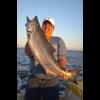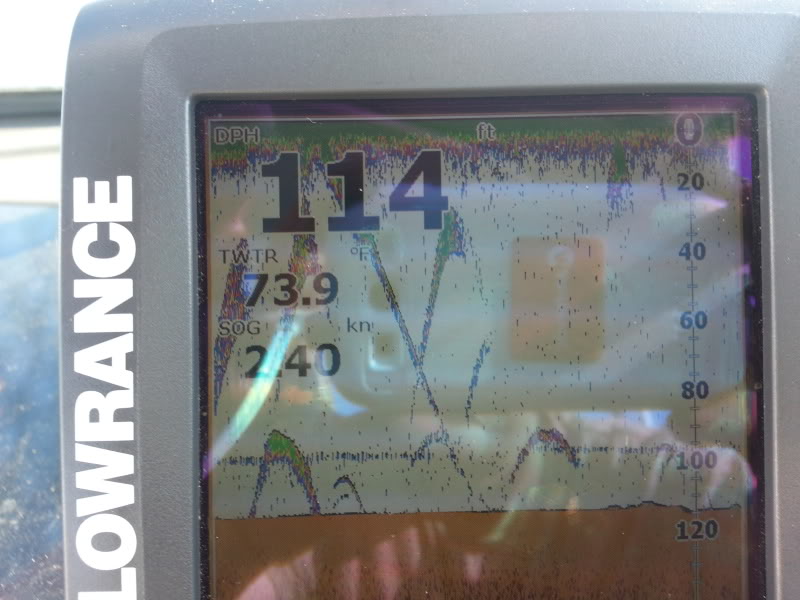-
Posts
816 -
Joined
-
Last visited
Content Type
Profiles
Forums
Events
Gallery
Store
Posts posted by stoutner
-
-
Pretty funny that the guys on Seneca got tired of getting beat up by the guys on Cayuga. Now you have to start a Seneca North vs South rivalry. That is pretty sweet.
Sent from my SCH-I535 using Lake Ontario United mobile app
-
Reel Turner will be fishing with most of Team Green Dolphin out of Stivers Marina on a 22' Starcraft Islander. We will stop by and visit at Sampson.
Sent from my SCH-I535 using Lake Ontario United mobile app
-
Reading this thread makes me want to call in sick and hop on one of you guys' boat
 I'll stop down at the weigh in Friday night and say hello.
I'll stop down at the weigh in Friday night and say hello. Sent from my SCH-I535 using Lake Ontario United mobile app
-
Problem with difficult fishing in a NO-Communication event is that you have no idea if everyone else is struggling also. This past weekend had to be the toughest Salmon fishing in a long long time. The boat I was on was marking fish one after another along with huge bait pods but no matter what they did they couldn't get them to turn on.
It was refreshing to see most of the top Lake O teams struggle like that. Kind of puts it into perspective for me.
-
Thanks guys,
This is actually a better video I took with more editing and sound. The copter is basically hovering on autopilot.
Turn on speakers.
-
Looking forward to doing a little filming this weekend in Wilson.
I was practicing up a little on my own last night out of Sodus Point.
This is just a quick video and quick editing job from last night. The Trojan runs smooth as silk in that flat water

-
I have been reading this and I can't believe all the cackling going on. Fish our U.S. waters and that's it. Don't like it don't fish the tournament. Everybody is now on the same playing field, period. Enjoy, be safe, and catch fish. No, I am not fishing this event.
Well said. Funny how a guy spends hundreds or more man hours to put on such a great event and gets blasted for something that is so obvious to most of us.
-
-
Once you have first mated for a while you would realize that the first make makes more money than the Captain

-
It's a very nice cottage. I checked it our last week. Seemed very clean with 4 bedrooms and 8 beds total.
-
Congrats on the great day! Many boats have been reporting anywhere from 12 - 60 Browns with many of them reporting over 20. But, if the colored water leaves then you can just as easily get skunked!!!!
Great job!
-
Pm sent
Sent from my iPhone using Lake Ontario United mobile app
Going bigger already

-
Bring it on. I had it coming. I know how to take it like a Man
I think most of us are on here to talk about fishing and maybe learn a little bit too. I try to keep an open mind but am pretty stubborn most of the time. I would still be fishing Evil Eye spoons and Dodgers / rubber squids if I hadn't been told a dozen times that there are better options out there.
-
Very good points Kayaker. I forgot about the "arc" created and that also is a huge factor in how much your ball rises as you increase either speed and/or depth. I remember it being about 25% off when running a 12 lb weight at about 100 down doing about 2.6 mph. My actual depth probe was saying I was only about 75 down and my sonar might have been reading something like 90 down due to the arc in the rigger line when it should have stayed at 100 down. In either case, that probe taught me a lot about where my downriggers were fishing. Taught me to make sure I buy really heavy weights to help alleviate some of that. It also showed me that speed makes a HUGE difference. You go from 2.2 to 2.8 and your weight blows way back and rises much more than you would think especially if you are running 12 lbs or less.
You can really tell a lot if you can understand your sonar better. That Doctor Sonar article is great.
-
http://doctorsonar.com/blogs/educational-articles/12380345-lowrance-pros-corner-by-luke-morris
See critical concept #3 towards the end of this article. Replace the word fish with weight and imagine that the fish in the first diagram is a downrigger weight.
That is a really good read. Thanks for that link. ...and that was a really good "Google Search"

I also like this last sentence in critical concept #2 "This does not mean the suspended fish was 16 feet deep. Only that at the closest
point it was 16 feet from the transducer, while the boat was in 31 feet of water."
This would apply to the downrigger ball as well....
-
I have no problem. When trolling to see every little thing my balls are doing when I speed up they swing out and rise when I slow they drop. When I set them on bottom and drag I can see that too. All under power. When I turn some rise a little some drop a little. All this is visible On my soNar While my balls are not directly under the boat. If what your saying is true. Then there would be no rise at On the ball when I speed up. If your theory is correct then the cannon digitroll Setup would be a compete fraud Because their bottom tracking rigged to a humming bird ff would not be acurate as they claim I personally don't Havd one. But I know a couple people that swear by them. You are definatly a well informed person but you are still wrong. I have been waiting on the phone to raymarine. For an hour If I ever get thru I'll ask them what they think. I'm actually calling them cause I am in the process of rigging up my new evolution autopilot and trying to network it to everything else on boat If I'm wrong I'll admit it. But I'm not
Hey - No worries. You and I are a lot alike. We both run Raymarine, both run heavy downrigger weights, and both think we are right all of the time!!!! I have Raymarine autopilot and a separate C127 plotter with all of my stuff networked together including my Raymarine Radar. I am very happy with all of it. You should buy a Fishhawk X4D or one of those new smart troll units. That would settle it once and for all.
-
I didn't mean you! You're on it.
I thought so. That post was for Hobbit

-
That's a nice Atlantic Pretty fish.
-
So I guess then a true measurement of where your torpedoes are would be to drop them down while in neutral (and flat calm seas) and see if the depth on the riggers matches your sonar. Then engage and slowly bring up the speed and see if the depth changes. I agree with what your saying. The only thing that makes me question this theory is that when I'm running my 4 torpedoes, if i have guys move quickly to one side of the boat I can see the opposite side torpedoes lift up and down. It kind of looks like a small mm instead of a straight line. Same thing in big waves, you can see the torpedoes rocking back and forth with the waves.
You are correct. Just go really slow are stop completely to check to see if they match. You see the mmmm when you are rocking from one side of the boat because your transducer is near the pivot point and the weights are actually getting a little closer or further away as you boat is rocking side to side.
My Raymarine C125 is a very good fish finder. It displays in color like most units do. I can tell (somewhat) if I pass directly over the fish or not based on the color of the mark. If the "tails" on the mark are blue/black and the top of the mark is bright red, I am pretty sure that fish passed very close to directly under my boat. When it is bright red you can pretty much be assured that the depth you are seeing that fish at is accurate. If I see a mark that is all light blue with no red in it I am pretty sure that fish was off to the side a fair distance and therefore probably higher in the water than what is displaying on my screen. That may not always be the case but that is my experience.
I was amazed when I first started using that Fishhawk X4D that measures depth. I have 12 lb weights that I use for depths to about 60 feet. I have 16 lb torpedos on my outer riggers and a 20 lb Shark on my probe rigger. I can tell you that it is nearly impossible to get down to 125 feet with 12 lb weights. I would have to let out 175 - 200 feet of downrigger to get to 125 feet when running about 2.6 mph. That is exactly why I spent the money on the heavier weights. Most of what i am talking about becomes a little irrelevant if you are using good heavy weights.
-
Per Google

Sound travels through fresh water at a speed approximately 4920 feet per second. What a sonar device (depth finder / fish finder) does is to measure the amount of time for a burst of energy to travel to bottom and return to surface. This time variation is then displayed on the readout of your sonar device by means of flashing lights, Liquid Crystal Display (LCD), or Cathode Ray Tube (TV screen). When the depth gets deeper, the time of travel for the sound increases.
An electronic “power pack†generates very short bursts of electrical energy which are sent to a transducer, which operates as a “loudspeaker†to convert those short bursts, or pulses, of electrical energy into very short bursts of high frequency sound energy. After sending out a single burst of this high frequency sound, the transducer is switched over so that it now acts as a “microphone†to pick up the sounds of the returning echoes created when that pulse of sound hits the bottom of the lake (river, ocean, etc.) and possibly other objects (fish) which lie between the transducer and the bottom.
The returning echoes of this short pulse of high frequency sound are received back by the transducer (operating as a microphone) which converts sound energy into electrical energy. These tiny bursts of electrical energy, now much weaker than the original signal, are then put through an amplifier which increases their strength to the point that they can be used to light a neon bulb, Light Emitting Diode, or to activate a pixel on an LCD. Thelocation of the flashes on a dial or the location of the pixels on the display can then be used to indicate the RANGE, or distance, from the transducer of the object (bottom) or objects (fish) which have bounced back the echoes.
And the last sentence says it all

Sent from my SCH-I535 using Lake Ontario United mobile app
-
As of today, Sodus is ice free North of the Point and out to the lake. Coast Guard launch can be used. South of the point is still pretty thick with Ice. Arney's Marina is ice free but you can't go anywhere because the rest of the bay is a foot thick. Sodus Marina is still 75% iced in and so is Katlynns. I walked out to my slip in Sodus Marina and it was a foot or more thick at my slip.
Here is Sodus Marina this afternoon.
-
Actually sonar doesn't meSure in a straight line it is a cone in the water with the thinnest part at top going down to larger base I do to know what kind of electronics you run but I can watch my ball swing back and rise on my raymarine.
I run a Raymarine C125. How do you think those humps or upside down U's are created on your screen? If what you are saying is true, your marks would be straight lines that would look like short dashes and would not look like humps.
Look at this mark in the lower left corner of this pic. As you can see, the bottom of the mark is at 110 feet and the top of the mark is at about 90 feet. Is this a 30' tall fish? If this fish shaped like some kind of weird hump? Probably not but who knows.
What is happening is the fish is suspended in about 90 feet of water. As your sonar first picks it up, the fish is about 110 feet away from the transducer. As your transducer travels over top of it your sonar shows the true depth of the fish which is 90 feet. As the fish fades back behind your boat the the sonar shows it as being deeper and deeper all the way to 110 feet before the signal is lost. THAT is how the hump shape mark is created on your Fish Finder. That same scenario plays out when your downrigger weight blows back and naturally rises. The distance to the transducer remains the same and therefore it does not show your actual depth....it just shows how far it is from the transducer.
P.S. I am just trying to share some information. If you disagree that is O.K. Just think about it a little and test it out on the water. It makes a huge difference when fishing deep and fishing fast. At 50 or 60 feet and 2.2 mph it doesn't matter much. at 100 feet and 2.5 mph it makes a huge difference.
-
Agree or not.... your sonar measures a straight line from your transducer to your downright ball. If your d ownrigger counter reads 100 down, your sonar should also read 100 down. Problem is that with blowback your ball is probably only 80 down. I have a fishhawk X4D which measures actual depth and it proves this every time I fish.
Prove it yourself. Just run at 1.5 mph and check your sonar. Then speed up to 2.5 and your sonar will read the same depth. Common sense will tell you that your ball is blowing back and therefore up in the water column. Your sonar reading will read the same.
Sent from my SCH-I535 using Lake Ontario United mobile app
-
Sodus isn't exactly clear. The chute is open and the very North end of the bay is open behind Capt. Jacks and that area. The rest of the bay is about a foot thick from what I hear from a couple of ice fisherman. It does change every day though so who knows.
You cold in theory get out with a small trailer-able boat but if the ice starts to break up and the wind blows some of it out of the bay you would have to beach the boat on the lake side to get out. ...or go to another port.
I'd be very surprised if the bay is 100% ice free by April 5th. I know some of the guys who have charters booked that weekend have cancelled. Maybe by the weekend of April 12th it will be all clear? I don't plan on putting in until April 20th or so.






Seneca Lake 50th Lake Trout Derby Shout out! North vs South
in Finger Lakes Discussion
Posted
At the Cayuga victory party
Sent from my SCH-I535 using Lake Ontario United mobile app